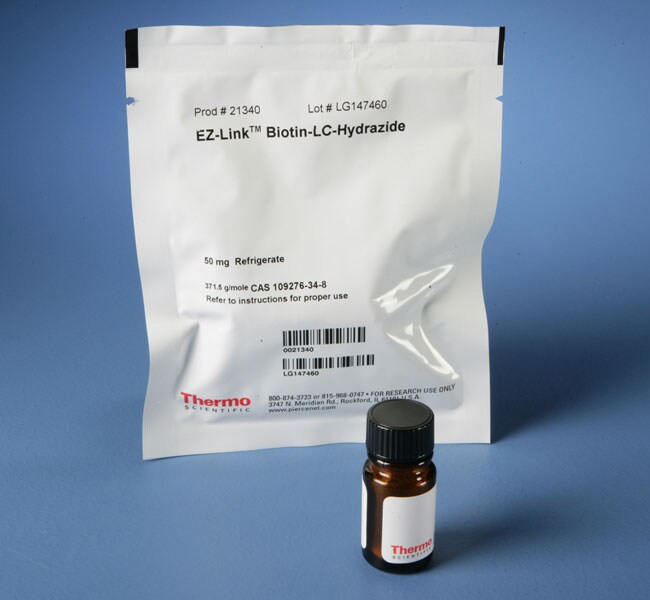Search

Citations & References (2)
Thermo Scientific™
EZ-Link™ Biotin-LC-Hydrazide
Thermo Scientific EZ-Link Hydrazide-LC-Biotin is a mid-length, simple, hydrazide-activated biotinylation reagent for labeling glycoproteins and other carbohydrate-containing compounds having oxidizableRead more
| Catalog Number | Quantity |
|---|---|
| 21340 | 50 mg |
Catalog number 21340
Price (MXN)
-
Quantity:
50 mg
Thermo Scientific EZ-Link Hydrazide-LC-Biotin is a mid-length, simple, hydrazide-activated biotinylation reagent for labeling glycoproteins and other carbohydrate-containing compounds having oxidizable sugars or aldehydes.
Features of EZ-Link Biotin-LC-Hydrazide:
• Glycoprotein labeling—biotinylate glycosylated proteins at sialic acid residues for detection or purification using streptavidin probes or resins
• Cell surface labeling—biotinylate and isolate cell surface glycoproteins
• Aldehyde-reactive—reacts with aldehydes formed by periodate-oxidation of sugar groups
• Hydrazide-activated—perform reactions at pH 4 to 6 in buffers such as sodium acetate
• Irreversible—forms semi-permanent hydrazone bonds; spacer arm cannot be cleaved
• Solubility—usually dissolved in DMSO before further dilution in aqueous buffers
• Spacer arm length—24.7Å
This biotin hydrazide reagent enables simple and efficient biotin labeling of polyclonal antibodies and other glycoproteins. Mild oxidation of antibodies with sodium periodate produces reactive aldehydes on the carbohydrate moieties of the Fc portion that can be modified by hydrazides. This approach is advantageous for labeling antibodies because biotinylation occurs only at the sites of glycosylation, which are primarily in the Fc region of the antibody, far from the antigen binding site.
We manufacture biotin reagents to ensure the highest possible overall product integrity, consistency and performance for the intended research applications.
Biotinylation reagents differ in reactivity, length, solubility, cell permeability and cleavability. Hydrazides and alkoxyamines are two types of carbonyl-reactive groups. Hydrazides (—NH-NH2) react specifically with aldehyde groups in slightly acidic conditions to form hydrazone linkages; these can be further reduced to stable secondary amine bonds using sodium cyanoborohydride (Part No. 44892). The reaction is more efficient in the presence of aniline (Part No. 88944). Alternatively, hydrazides can be conjugated to carboxylic acids using EDC carbodiimide chemistry.
Reactive aldehyde groups can be generated in glycoproteins and other polysaccharide compounds by oxidation of constituent sugar diols using sodium periodiate (Part No. 20504). Sialic acid residues are common components of protein glycosylation and are easily converted to aldehydes with 1 mM NaIO4.
Related Products
EZ-Link™ Hydrazide-Biotin
Features of EZ-Link Biotin-LC-Hydrazide:
• Glycoprotein labeling—biotinylate glycosylated proteins at sialic acid residues for detection or purification using streptavidin probes or resins
• Cell surface labeling—biotinylate and isolate cell surface glycoproteins
• Aldehyde-reactive—reacts with aldehydes formed by periodate-oxidation of sugar groups
• Hydrazide-activated—perform reactions at pH 4 to 6 in buffers such as sodium acetate
• Irreversible—forms semi-permanent hydrazone bonds; spacer arm cannot be cleaved
• Solubility—usually dissolved in DMSO before further dilution in aqueous buffers
• Spacer arm length—24.7Å
This biotin hydrazide reagent enables simple and efficient biotin labeling of polyclonal antibodies and other glycoproteins. Mild oxidation of antibodies with sodium periodate produces reactive aldehydes on the carbohydrate moieties of the Fc portion that can be modified by hydrazides. This approach is advantageous for labeling antibodies because biotinylation occurs only at the sites of glycosylation, which are primarily in the Fc region of the antibody, far from the antigen binding site.
We manufacture biotin reagents to ensure the highest possible overall product integrity, consistency and performance for the intended research applications.
Biotinylation reagents differ in reactivity, length, solubility, cell permeability and cleavability. Hydrazides and alkoxyamines are two types of carbonyl-reactive groups. Hydrazides (—NH-NH2) react specifically with aldehyde groups in slightly acidic conditions to form hydrazone linkages; these can be further reduced to stable secondary amine bonds using sodium cyanoborohydride (Part No. 44892). The reaction is more efficient in the presence of aniline (Part No. 88944). Alternatively, hydrazides can be conjugated to carboxylic acids using EDC carbodiimide chemistry.
Reactive aldehyde groups can be generated in glycoproteins and other polysaccharide compounds by oxidation of constituent sugar diols using sodium periodiate (Part No. 20504). Sialic acid residues are common components of protein glycosylation and are easily converted to aldehydes with 1 mM NaIO4.
Related Products
EZ-Link™ Hydrazide-Biotin
For Research Use Only. Not for use in diagnostic procedures.
Specifications
Cell PermeabilityCell-Permeant
Label TypeBiotin & Analogs
Product LineEZ-Link
Product TypeBiotin-LC-Hydrazide
Quantity50 mg
Reactive MoietyAmine, Hydrazide
Chemical ReactivityCarboxylic Acid, Ketone, Aldehyde
Label or DyeBiotin
SolubilityDMF (Dimethylformamide), DMSO (Dimethylsulfoxide)
SpacerMid-length
Unit SizeEach
Contents & Storage
Store at 4°C.
Citations & References (2)
Citations & References
Abstract
Rare, high-affinity anti-pathogen antibodies from human repertoires, discovered using microfluidics and molecular genomics.
Journal:
PubMed ID:28846502
Affinity-matured, functional anti-pathogen antibodies are present at low frequencies in natural human repertoires. These antibodies are often excellent candidates for therapeutic monoclonal antibodies. However, mining natural human antibody repertoires is a challenge. In this study, we demonstrate a new method that uses microfluidics, yeast display, and deep sequencing to identify
Fibroblast-specific inhibition of TGF-ß1 signaling attenuates lung and tumor fibrosis.
Journal:J Clin Invest
PubMed ID:28872461
TGF-ß1 signaling is a critical driver of collagen accumulation and fibrotic disease but also a vital suppressor of inflammation and epithelial cell proliferation. The nature of this multifunctional cytokine has limited the development of global TGF-ß1 signaling inhibitors as therapeutic agents. We conducted phenotypic screens for small molecules that inhibit